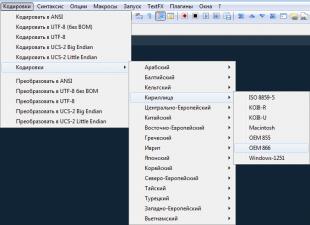Our site has already managed to tell before. Recall that this is the so-called recovery menu, with which the user can, for example, reset all data or reflash his gadget.
There are two types of recovery menu (Recovery Mode): stock and custom. Stock - this is the same type of Recovery Mode, which is installed by default. When flashing, a custom Recovery Mode can be installed.
And now - the most interesting. It will be about how to enter the recovery menu. And here an interesting quest can await the user - on various devices this mode can be started in different ways. How exactly? First, we will tell you about the universal method, and then we will go through specific brands of smartphones and tablets.
Universal mode
Why is he good? The one that is relevant for most modern devices.
- Turn off your device by pressing the Power key, then tap on the menu touch button"Switch off".

- After the device is completely turned off, you will need to press the volume down key and the Power key at the same time.

- Or - on the volume up key and the Power key at the same time.

- When the device starts, the Power key can be released.
This is the most convenient way of all and the easiest to start the specified mode.
How to enter recovery on samsung?
For new models: press the volume up key, Power and the central Home key.

For older models, a universal method is used: pressing the volume up or down key, as well as Power.
Google Nexus
Volume down key + Power.

In this case, Fastboot mode will be loaded, and from there it will be possible to switch to Recovery Mode.
LG
The classic way: volume down key + Power. Please note that the volume up and down buttons on LG smartphones may be located on the back.

Xiaomi
Volume up + Power.

Meizu
Volume up + Power.

Please note that Meizu has its own menu, with which you can reset the settings or update the firmware. This is not quite a recovery menu.
HTC
Or volume up + Power:

Or volume down + Power:

Huawei
Volume up + Power.

Or decrease the volume + Power.

Motorola
First you will need to launch Fastboot Flash Mode, for which press the Volume Down + Power button.

In the menu that will load on the screen, go to Recovery Mode using the volume down and volume up keys.
ASUS
Classic variant. Or Volume Down + Power:

Or Volume Up + Power:

Sony
There are several ways.
The first is simple: Volume Up + Power.

The second one is a bit more complicated: the Power button, then Up, the Sony logo appears and Up again.
The third way: Volume Up + Volume Down + Power.
How to enable Recovery Mode via terminal?
Download the Terminal Emulator app. Run, grant root rights (mandatory).
Write the reboot recovery command.

The gadget starts in Recovery Mode.
How to enable Recovery Mode through a computer?
Install Adb Run, as well as the necessary drivers. Connect the device to the computer, run on the computer command line, enter the adb reboot recovery command and press the Enter key.
Once again, let's talk about the Recovery menu, since almost always the instructions for flashing and upgrading Android provide for the performance of certain actions from the Recovery menu.
What is Recovery?
Recovery (recovery) or translated from English - Recovery Mode is a special device boot mode with which you can restore the system or install updates. This is an emergency mode necessary to restore the working state of the mobile device in the event of program failures, which resulted in the device turning off and the inability to boot it in normal mode.
With the Recovery mode, you can:
- Reboot your tablet or smartphone.
- Reset settings.
- Install updates.
- Configure and install firmware.
- Get Root rights.
- Delete your personal data in the system.
- Restore the operating system and much more.
Remember that incorrect actions can harm the system. If your tablet has important information, it is better to save it on another device in advance.
Before using the recovery mode, carefully read the instructions. Each tablet has a different service menu, so the question of how to enter the Recovery menu on a tablet requires an individual approach.
How to enter Recovery?
Recovery mode in each mobile device differs visually, but the login process is almost always carried out according to the same principle. In order to enter the Recovery system, you need to do a number of actions:
1. Turn off your tablet. At the same time, make sure that the battery is fully charged or connect the tablet to the network.
2. Switch to Recovery mode by pressing a combination of some buttons. Since different tablet manufacturers offer different hotkey combinations, we will give some of the most common key combinations for entering the recovery menu.
The main key combinations for entering the Recovery:
- Simultaneously holding down both the "volume" keys and the "power" key;
- simultaneously pressing one of the "volume" keys and the "power" key;
- simultaneously hold down one of the volume buttons, the Home button and turn on the device.
The buttons are held until the recovery mode appears on the display.
On some Chinese devices there is no Recovery mode. In this case, you will have to reflash the tablet.
How to navigate the Recovery menu?
Most devices allow you to navigate through the menu items using the volume buttons. The power button serves as a choice of the desired menu item. Some devices may use other keys.
If the control is touch, then we move through the points and select the desired item by pressing your finger.
How to enter Recovery if there are no volume keys on the tablet?
If your tablet does not have volume keys, try the following tips:
1. You can try to enter the desired mode by holding down the power and Home buttons at the same time. Another option is to hold down the Home key, press the power button, and release the Home key. After the splash screen appears, press the Home button again.
2. You can navigate through the menu by connecting a USB keyboard via an OTG cable or using a sensor.
If you do not know how to enter the recovery, this instruction is for you. Here we list all possible ways completion of this task.
1. Use the keys
The easiest and most common way to enter Recovery Mode is to turn off your smartphone / tablet and hold down two or three buttons on the turned off (this is important) device.
Here are all the currently known combinations:
- volume up + power button (Lenovo, HTC, Samsung, Meizu, Xiaomi, Sony, Huawei, Fly, Asus, Doogee, Bluboo, Blackview, Oukitel, Elephone, UMI and other Chinese devices);
- both volume buttons + power key (Lenovo, Sony);
- volume down + power on (Nexus, HTC, LG, Huawei, Motorola, Fly, Asus);
- home button + volume up + power on (Samsung);
- Home button + power on (Samsung);
- turn on + volume up until the logo appears and once again increase the sound after it appears (relevant, for example, in Sony devices).
Depending on the manufacturer, the pressing method may be different. Sometimes you just need to hold and hold until the Android recovery menu appears. In some cases, a single press of all or one of the buttons is sufficient.
For LG, you need to hold down the above keys exactly until the logo appears, and then release and press once again.
In Motorola, after using the combination, the so-called Fastboot Flash Mode will appear. Using the same volume keys, you will need to switch to Recovery Mode.
Everything is not so simple with Asus phones. There you need to hold down the buttons until the vibration appears, and after it, keep only the volume. This should be done until the desired mode appears.
Happy owners of Xiaomi, when using the appropriate combination, will see a set of tiles with Chinese characters. You should not be afraid. Click on the button shown below (left) using the arrow, which will give you the option to change the language to English. Then click on the inscription "recovery" to enter TWRP.

Rice. No. 1. Switching to recovery on Xiaomi
On Chinese devices, you also often have to additionally select "Recovery Mode" using the volume keys.
Advice: It is best to find the relevant information in the instructions or on the manufacturer's website.
If none of the combinations above worked for you, try others. At least one should work. And if not, you can always complete the task using a computer.
2. We use the capabilities of the computer
step by step this process as follows:
- You will need the Android SDK to work. You can download this program (download files are below, you need to select the file that matches your operating system). Run her.
- After downloading, run the file with android.exe. Check the box next to "Android SDK Platform-tools". Click the "Install 1 packages" button. If a license window appears, agree to it by clicking the "Install" button.

Rice. No. 2. Window Android installations SDK
- Install the Java Development Kit from this page. There, you also need to select the file corresponding to the operating system.
For reference: On the drive where you installed the Android SDK, there will be a "tools_[your operating system version]" folder. And in it is another folder - "platform-tools". It contains ADB. This is just so you know.
- Now download from the official website of the manufacturer of your gadget latest version driver and install it.
- On your smartphone/tablet, open the settings. Go to the "About phone" or, respectively, "About tablet" item. Find the line "Build number" there and tap on it 7 times.
- A new item will appear in the settings - "For developers". Go into it. There, click on "USB Debugging" to enable this feature.

Rice. Number 3. "USB Debugging" in the "For Developers" menu
- Connect your device to your computer using USB cable.
- Launch Windows Command Prompt. It is usually found in the start menu. As a last resort, you can always enter “cmd” into the search and run the program found.
- There, run a command like "cd \tools_[Windows Version]\platform-tools". Press "Enter" on your keyboard.
- Run the "adb reboot recovery" command next.

Rice. No. 4. Executing a reboot command
After that, the device will reboot and start in recovery mode.
Now you know how to enter TWRP using a computer.
3. Use the terminal
Android also has a terminal, like Linux. But you need to download and install it - here is the link. In those, first enter the command "su" and then "reboot recovery". Between this, the program may request root access. Agree.

Rice. No. 5. Entering the command to start the recovery in the terminal
All this will help to complete the task.
Let's describe the possible options for getting into the Recovery menu on smartphones and tablets from different manufacturers. Recovery menu (Recovery menu, recovery menu) allows you to do, clear different areas of memory. It is also used for Getting Root and phone firmware.
How to enter Recovery
Disconnect the charger or USB cable from your device!
1. The most common way.
- Turn off your smartphone.
- Clamp center button (home).
- Press key volume up and power button.
- Hold until the green robot appears on the display.
This approach works for many modern smartphones and Samsung tablets.

2. Center key + volume down + inclusion.
3. Volume up key + inclusion.
4. Volume down + food(suitable for most HTC).
5. Center key + food.
Rare ways to enter Recovery
Some manufacturers have tricky ways to enter the recovery menu.
Yes, at Lenovo to enter Recovery you need:
.To call the Recovery menu on smartphones Sony:
- Turn off the device.
- Turn on.
- When the logo appears or the power indicator turns on, hold down either Volume + or Volume -, or tap on the logo on the display.
To enter Recovery on devices Fly sometimes you have to go through a whole ritual:
- clamp Volume+ and Food.
- When the Fly logo appears, release the Power button.
- After the green robot appears, release the Volume + key.
- Briefly press the Power button.
Keep in mind! Recovery menu may be missing. Naturally, in this case it is impossible to enter it.
Like any operating system, Android has a special boot mode where the device turns on but the system itself does not boot. This mode is called Recovery Mode, or in Russian recovery mode. This mode is present in any Android device and allows you to reset the settings, change the firmware, restore the firmware from backup or just in case of a hang. It is noteworthy that, unlike root rights, using Recovery Mode is not dangerous, so it is not blocked by the developer in any way. This function can be used by absolutely everyone and completely officially. Let's take a closer look at how to enter the recovery on any device running Android, and what each menu item is responsible for.
Recovery Mode gives access to the system functions of the deviceWays to enter Recovery mode
On the device itself
Standard way. The principle of entering Recovery Mode is the same for all devices - when you turn it on, you need to hold down several buttons. Most often this is the volume up, but there may be such options:
- Samsung - power on + volume up + "Home".
- LG - turn on + volume down.
- Google Nexus, HTC - turn on + volume down, then tap Recovery.
- Certain models of Lenovo, Motorola - power on + volume up + "Home".
- Sony - power button, after double vibration, hold down the volume up.
If for some reason enter Recovery Mode standard means If it doesn't work, try to clarify in the instructions. The listed combinations work in almost all cases and will work both for entering the standard recovery menu and custom ones. In addition, you can run even when the tablet does not boot or the system freezes.
If you have root rights, you will need installed application Terminal Emulator (https://play.google.com/store/apps/details?id=jackpal.androidterm). After installation, you will need to allow superuser rights and enter two commands: first su, and then reboot recovery. The device will reboot.

Via computer
A prerequisite is the enabled debugging mode via USB (Settings - For developers - Debugging via USB, or select the appropriate item when connecting to a PC). Therefore, if this mode was previously disabled, the tablet does not start, you will not be able to use it.
You will need the ADB Run program (http://cloud-androidp1.in/Android/PC/Project_Site/AdbProgramm/), a cable, and a working device.
- Connect your device to your computer.
- Run ADB Run.
- In the program menu, press 4 and then 3 in sequence.

The device will reboot into Recovery Mode. You can follow the procedures you need.
How to use Recovery Mode
As we have already said, there is both a standard recovery and a custom one, or a user one. Many experienced users claim that the possibilities of the first one are rather scarce, so it is better to install an unofficial one for it. We will talk about them a little later, but now we will analyze what Recovery Mode menu items you can find on your device.
Install zip from sdcard - install an archive with updates saved on a memory card. Through this menu root-rights are obtained and firmware is performed.
Wipe data / factory reset - wipe data / factory reset - complete cleaning of the system partition, resetting all settings to their original state. All apps and settings will be removed, but media files will remain intact. Used for critical errors, system crashes, or when running new firmware. Particularly effective remedy in cases where the device does not turn on.
Wipe cache partition - cleaning the system cache - a system partition that stores temporary files and all program settings. It is advised to perform when the firmware changes.
Backup and restore- backup systems and restore from previously created backups.

Mounts and storage - for correct operation, all system partitions must be properly mounted and connected. Often, this procedure is performed automatically, but sometimes something has to be corrected manually. You can also clear one of the partitions. We advise you to use this method only in case of a specific need, otherwise file system will not boot and the tablet will not work.
advanced- additional settings, including rebooting Recovery Mode, clearing dalvik cache, resetting permissions system applications. Most often used by professional programmers.
Management, unless otherwise indicated, is carried out through (navigating through the list) and power (selecting a menu item). In some cases, the selection occurs with the volume up, and scrolling with the volume down. In any case, the system necessarily indicates exactly how to manage the menu sections. There are developments with touch control.
Unofficial Recovery
As mentioned above, the standard Recovery Mode very often has somewhat limited capabilities, so it is best to use third-party, unofficial developments. The most popular are two of them - ClockworkMod recovery (CWM for short) and TeamWin Recovery Project (TWRP for short). Both developments have excellent functionality and allow you to modify or change the firmware very quickly and conveniently, get root rights, reset the settings to factory settings or restore a backup copy.
 uptostart.ru News. Games. Instructions. Internet. Office.
uptostart.ru News. Games. Instructions. Internet. Office.



